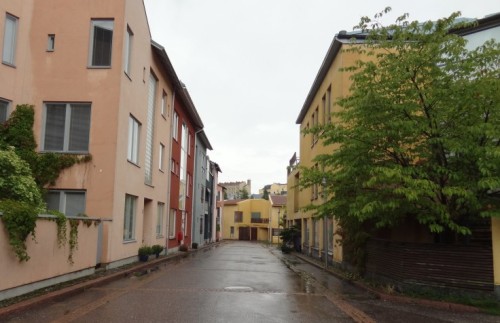 From Timo Hämäläinen via Tracy Gaton: "Back in 2012, I wrote about Helsinki’s interests towards introducing townhouses as a housing concept. Later on, we organized a seminar around the topic. To add some out-of-the-box thinking on the issue, we invited a speaker from Stockholm because structures referred to as 'townhouses' had also gained attention in the Swedish capital. At the end of my recent European Urban Cultures studies, I decided to compare what the fuss about townhouses is all about. It became the topic of my master’s thesis. You can find the full study here.
"Townhouses have many qualities that support the needs of the modern urban individual. The basic structure of the building can be used in many ways to create a variety of dwelling types within the same block or even the same building. Furthermore, the vertical circulation of a single housing unit can relatively easily be split into multiple units to accommodate expected or unexpected changes in life. Similarly, it allows multiple generations to live under the same roof which is common in many cultures. Townhouses also create urban milieus, because they are predominantly connected directly to the street and support high population densities. The ground floor may easily be transformed into a commercial space or work space.
From Timo Hämäläinen via Tracy Gaton: "Back in 2012, I wrote about Helsinki’s interests towards introducing townhouses as a housing concept. Later on, we organized a seminar around the topic. To add some out-of-the-box thinking on the issue, we invited a speaker from Stockholm because structures referred to as 'townhouses' had also gained attention in the Swedish capital. At the end of my recent European Urban Cultures studies, I decided to compare what the fuss about townhouses is all about. It became the topic of my master’s thesis. You can find the full study here.
"Townhouses have many qualities that support the needs of the modern urban individual. The basic structure of the building can be used in many ways to create a variety of dwelling types within the same block or even the same building. Furthermore, the vertical circulation of a single housing unit can relatively easily be split into multiple units to accommodate expected or unexpected changes in life. Similarly, it allows multiple generations to live under the same roof which is common in many cultures. Townhouses also create urban milieus, because they are predominantly connected directly to the street and support high population densities. The ground floor may easily be transformed into a commercial space or work space.
"So how does townhouse development in Helsinki and Stockholm compare against these assumptions for primary motives? The Stockholm townhouses fit more accurately to this picture than the Helsinki ones do. However, the Stockholm townhouses are not explicitly connected with ambitions of offering flexible housing types for a fragmented demographic make-up or a multicultural population. In Helsinki the townhouse on the other hand is primarily assimilated with the suburban single-family home. [Of course this generalization about Helsinki has exceptions, such as pictured above.]
"These ideas are also expressed in the materialization of townhouses. In Stockholm inner city townhouses are married to urban apartment-living even more clearly. The concept is built on rooftops, incorporated into the ground floors of apartment buildings, and introduced into refurbished old industrial buildings. In Helsinki, existing and the majority of planned townhouses have a suburban configuration. They are built in areas where cars are a near necessity.
"One reason behind these very different conceptualizations of the townhouse is that in Helsinki they have emerged as public interventions whereas in Stockholm they are built largely independent of public policy. Townhouse development in Helsinki is additionally strongly linked to a desire to protest against the building and construction industry that is argued to produce monotonous buildings and one-size-fits-all apartments. Townhouses are coupled up with encouraging group building or even direct owner-control of the building process of a single townhouse slice." Full post here.
